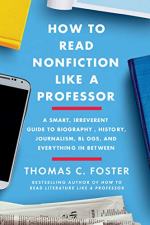
|
| Name: _________________________ | Period: ___________________ |
This quiz consists of 5 multiple choice and 5 short answer questions through Section 4: Chapter 13,"On the Stump" through Chapter 15, "Reading Internet Sources".
Multiple Choice Questions
1. In Chapter 3, "The Power of the Prologue," what does Foster say distinguishes the prologue from a preface?
(a) The word preface is generally only used for fiction.
(b) The word prologue is generally only used for fiction.
(c) The word preface is generally only used with narratives.
(d) The word prologue is generally only used with narratives.
2. In Chapter 10, "From the Inside Out," Foster says that the placement of newspaper columns often creates a "dichotomy." What is he accusing them of doing?
(a) Making it difficult for readers to find information outside of the two-party system.
(b) Creating the impression that there are only two possible points of view.
(c) Making it difficult for readers to understand the nuances of their arguments.
(d) Creating the impression that fair and balanced coverage is unimportant.
3. In Chapter 10, "From the Inside Out," what document does Foster call the "ultimate political expression of [the] Enlightenment insistence on the individual" (146)?
(a) A Room of One's Own.
(b) Essay Concerning Human Understanding.
(c) The Declaration of Independence.
(d) Apologia Pro Vita Sua.
4. Whose Apologia Pro Vita Sua is discussed in Chapter 11, "Life from the Inside"?
(a) Augustine of Hippo.
(b) The Rev. Dr. Martin Luther King, Jr.
(c) John Henry, Cardinal Newman.
(d) Charles Kingsley.
5. In Chapter 11, "Life from the Inside," Foster discusses the use of parallelism. He is discussing what technique?
(a) The use of tone that mimics the subject under discussion.
(b) The exact repetition of words and phrases.
(c) The use of multiple, similar examples.
(d) The repetition of grammatical structures.
Short Answer Questions
1. In Chapter 2, "The Ecology of the Nonfiction Biosphere," what does Foster call the "second draft of history"?
2. In Chapter 2, "The Ecology of the Nonfiction Biosphere," Foster says that rules are determined by content, not codex. What does this mean?
3. In Chapter 12, "Life from the Inside," why does Foster think Ambrose chose Merriwether Lewis's perspective for his history Undaunted Courage?
4. In Chapter 14, "The Universe of Ideas/Ideas of the Universe," why does Foster introduce the example of Malcolm Gladwell?
5. In Chapter 12, "Life from the Inside," what advantage does Foster say elapsed time gives to historical accounts?
|
This section contains 491 words (approx. 2 pages at 300 words per page) |

|




